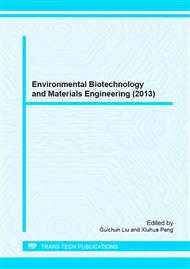[1]
H.Z. Wang, Y. Li: The new development of biological nitrogen elimination process-SHARON and ANAMMOX. Technology of Water Treatment, Vol. 28(2002), pp.308-310.
Google Scholar
[2]
H.L. Shang, Y.Z. Peng, J.R. Zhang and S.Y. Wang: The effect of temperature on short-cut nitrification and denitrification. Acta Scientiae Circumstantiae, Vol. 29(2009), pp.516-520.
Google Scholar
[3]
J.X. Fu, Y. Wang, T.H. Sun, F.Q. Chi, L.C. Zhang and X. Qi: Study on shortcut nitrification in SBR system at low temperature. Technology of Water Treatment, Vol. 34(2008), pp.29-32.
Google Scholar
[4]
P. Deng, X.M. Li, W. Yang, S.Q. Zhang, G.M. Zeng, Y. Zhang and S.L. Yi: Complete Nitritation Process in an Biolfilm Moving Bed System by Controlling pH. Environmental Science, Vol. 28(2007), pp.1720-1725.
Google Scholar
[5]
G. Ciudad, R. Gonzalez, C. Bornhardt and C. Antileo: Modes of operation and pH control as enhancement factors for partial nitrification with oxygen transport limitation. Wat. Res., Vol. 41(2007), pp.4621-4629.
DOI: 10.1016/j.watres.2007.06.036
Google Scholar
[6]
X.Y. Han, S.J. Zhang, Y.P. Gan, H.C. Wang and Y.Z. Peng: Start up and maintain of nitritation by the inhibition of FA and FNA. Environmental Science, Vol. 30(2009), pp.809-814.
Google Scholar
[7]
H.J. Guo, F. Ma, Y.L. Shen: Effect of DO and pH on nitrosofication. Techniques and Equipment for Environmental Pollution Control, Vol. 7(2006), pp.37-40.
Google Scholar
[8]
L.Y. Li, Y.Z. Peng, Q. Yang, S.B. Gu and L. Li: Factors optimization of rapid start-up for partial nitrification in SBR process. China Environmental Science, Vol. 29(2009), pp.312-317.
Google Scholar
[9]
R. Blackburne, Z.G. Yuan and J. Keller: Partial nitrification to nitrite using low dissolved oxygen concentration as the main selection factor. Biodegradation, Vol. 19(2008), pp.303-312.
DOI: 10.1007/s10532-007-9136-4
Google Scholar
[10]
J.H. Fan, C.S. Zhang, Q. Fang and K.F. Zhang: Realization of simultaneous nitrification and denitrification via nitrite by controlling sludge age. China Water & Wastewater, Vol. 23(2007), pp.102-105.
Google Scholar
[11]
C. Wei and G.Y. Luo: Acclimation in partial nitrification process of long MCRT. Journal of Chongqing University, Vol. 27(2004), pp.111-113.
Google Scholar
[12]
H.Y. Li, Y. Zhang, F. Gao, T. Yu and M. Yang: Effects of hydraulic retention time(HRT) on nitrification performance and microbial community of conventional activated sludge(CAS). Environmental Science, Vol. 27(2006), pp.1862-1865.
Google Scholar
[13]
J.F. Ye: New Biological Denitrogenation Technology in the Treatment of Wastewater. Chemical Industry Press, Beijing, China (2006), pp.51-54.
Google Scholar
[14]
SEPA: Methods for the Examination of Water and Wastewater. China Environmental Science Press, Beijing, China (2002).
Google Scholar
[15]
A.C. Anthonisen, R.C. Loehr, T.B.S. Prakasam and E.G. Srinath: Inhibition of nitrification by ammonia and nitrous-acid. Journal Water Pollution Control Federation, 48(1976), pp.835-852.
Google Scholar
[16]
C.Y. Wu, Z.Q. Chen, Y.Z. Peng and X.H. Liu: Achievement and stability of shortcut biological nitrogen removal under real-time control. China Water & Wastewater, Vol. 22(2006), pp.39-43.
Google Scholar
[17]
Q.L. Xie, X.X. Li, Y.H. Li, S.H. You, L.W. Zhang and W.H. Wei: Startup and factors affecting of partial nitrification in sequencing batch reactor. Environmental Science & Technology, Vol. 32(2009), pp.134-137.
Google Scholar
[18]
F. Ma and H.J. Guo: Study on affecting factors of nitrosofication in sequencing batch reactor, Vol. 21(2005), pp.9-13.
Google Scholar
[19]
K. Gernaey, L. Verschuere, L. Luyten and W. Verstraete: Fast and sensitive acute toxicity detection with an enrichment nitrifying culture. Water Environmental Research, Vol. 69(1997), pp.1163-1169.
DOI: 10.2175/106143097x125911
Google Scholar
[20]
V.M. Vadivelu, J. Keller and Z.G. Yuan: Effect of free ammonia on the respiration and growth processes of an enriched Nitrobacter culture. Water Research, Vol. 41(2007), pp.826-834.
DOI: 10.1016/j.watres.2006.11.030
Google Scholar
[21]
L.J. Yuan, D.C. Peng and Z.Y. Wang: China Water & Wastewater, Vol. 16(2000), pp.29-31.
Google Scholar
[22]
C. Hellinga, A.A.J.C. Schellen, J.W. Mulder, M.C.M. van Loosdrecht and J.J. Heijnen: The SHARON process:An innovative method for nitrogen removal from ammonium-rich waste water. Water Science Technology, Vol. 37(1998), pp.135-142.
DOI: 10.2166/wst.1998.0350
Google Scholar
[23]
A. Gali, J. Dosta, M.C.M. van Loosdrecht and J. Mata-Alvarez: Two ways to achieve an anammox influent from real reject water treatment at lab-scale:Partial SBR nitrification and SHARON process. Process Biochemistry, Vol. 42(2007), pp.715-720.
DOI: 10.1016/j.procbio.2006.12.002
Google Scholar


